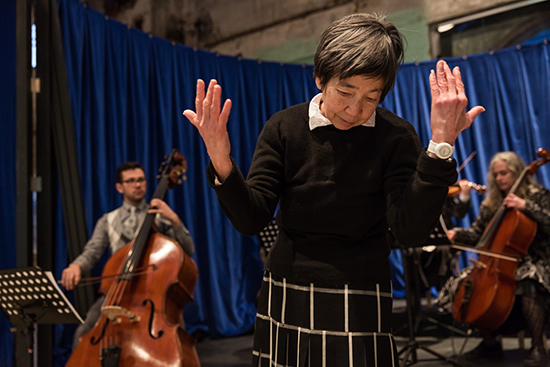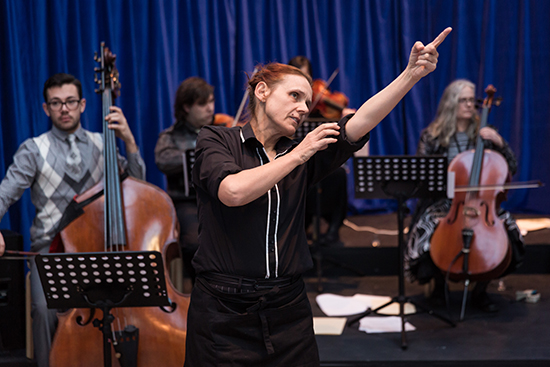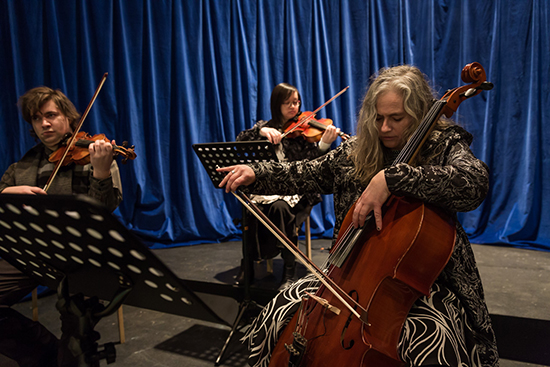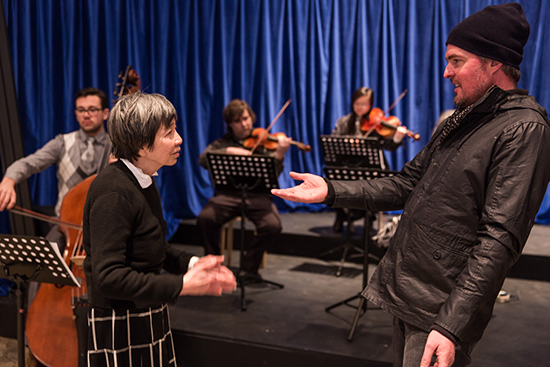Strengthening an all too fragile loop
Keith Gallasch: Urban Theatre Projects, Simple Infinity

Cheng Moy Yeow, Simple Infinity
When we willingly give ourselves to a work of art, we form a relationship with it, a loop of ongoing recall, enduring emotional and sensory responsiveness and reinterpretation. It’s little different from the way we love and befriend and constantly re-estimate relationships. The special pleasure offered by Urban Theatre Projects’ Simple Infinity is that it reveals the difficulty of connecting, especially for those ‘on the spectrum,’ by evoking the loop of social engagement, literally and metaphorically, in all of its complexity: a not so simple infinity.
Writer-director Rosie Dennis writes in her program note that “at the core of Simple Infinity is a desire to spark a deeper conversation in relation to mental health.” In the play, the metaphor “on the spectrum,” a descriptor for degrees of autism, is expanded, in several ways, into its colour components and used informally to suggest a range of emotional states of being rather than specific psychological conditions.
Despite initial resistance, Simple Infinity grew on me as I watched; grew into me as I reflected on and wrote about it. This writing is the translation into words of my experience of the work; my speaking back to it; my sustaining the loop generated by our coming together. I’m replying at length, in order to make sense of the experience—and to bring you into the loop—regardless of uncertain recollection and notes scribbled in dim light. In an era of diminishing critical returns for artists, I make no excuse for the number of words that follow.
Even if I hadn’t heard that the set design for Simple Infinity is premised on an infinity loop, the work’s recursiveness—a series of scenes that commence with “A man walks into a bar…”—its motif-driven dialogue and the characters’ shifting estimations of themselves and each other clearly welcomed me into an interpersonal phenomenological loop—if an emergent, delicate and unstable one.
First, we enter a narrow gap in a white high-walled, circular structure in the Carriageworks foyer and sit cocooned within one half of it facing a semi-circular, convex interior wall that pushes out towards us. After a signed welcome by one of the performers, Cheng Moy Yeow, she and another, Vicki Van Hout, slowly pull open the two large doors that constitute the wall, revealing the full extent of the space, curtained in a deep blue and home to a humble bar, table and chair…and a string quartet. What we then witness is a seemingly whimsical fabulation about how we engage with others.
The weather’s always a good starting point for a conversation (“phatic” or ritual communication as linguists call it). Van Hout chats amiably to us about the weather, then eating, then travelling, but with a looping compulsiveness, recursively posing what I/you/we might be experiencing: “Very nice weather we’re having. Very pleasant weather I am having. Very nice weather everybody is having. Very nice weather you are having.” And so on and on, but voiced charmingly rather than anxiously or manically. It’s a closed circuit. The opening of the set’s inner wall suggested perhaps that we were being invited into a world otherwise closed to us. But who speaks like this? Can the circuit be broken?
Tone (relaxed, warm, funny), style (poetic, minimalist, the music too) and theme (otherness, looping obsessiveness) have been established. The words, from Bon Marche Weather (1911), are Gertrude Stein’s (made her own by Van Hout), as are those at the end of Simple Infinity. But in between, the rest belong, in the Stein spirit (if lighter and more conversational) to the work’s makers.

Vicki Van Hout, Simple Infinity
Ultraviolet (Van Hout) runs the bar. The barmaid is Olive Green (Cheng Moy Yeow). They have a recurrent customer, a man of the sea, Midnight Blue (Luke Waterlow) who always arrives as if for the first time, striking coconut shells, as if horse-riding, and prefaced by the announcement, “A man walks into a bar…” This allows for some amusing advice from Violet: “Make it believable.” “Just be authentic. You don’t get a second chance.” When he arrives the same way later on, Violet quips, “Haven’t you got any new material?” The running gag lightly underlines the lack of progress in their barely initiated relationship and reminds us that humour is frequently repetitive and its use can appear sociable while remaining evasive.
Blue is initially regarded with wariness by the women. Violet asks him why he’s in the bar; his worrying response is, “I’m not prepared to be broken.” Making the link between the colour names for the characters and their mental states, Violet asks him, “What part of the spectrum are you?” He answers, “I’m emotional.” She responds, “That you are. Cue violins.” They play. Of herself she says, “I veer if the topic is uncomfortable. I can be a different person.” He declares, “I’m Midnight,” and exits, his discomfort about opening up evident, but he returns, and returns, if only to exit each time: “Some days are so heavy, it’s hard to breathe.”
These are people functioning at fundamental levels. Discussions about colour, cocktail making and conversation all deal with how to cope in the world and how to categorise experience. Violet: “Be attentive…check for fascination, look for anecdote.., never let your guard down.” Blue: “Listen empathically…use human rapport…abort if necessary.” Drink-mixing mirrors relationship combinations. The subject of Violet’s 50s Beat-like meditation on colour (“turquoise sits on the fence of blue/green”), inter-colour coupling and colourism is intoned to a fast, cool double bass brightened with pizzicato plucking. Of her own name, she says, “Violet, she’s beyond,” a reference to her full name, Ultraviolet, a colour that is off the spectrum.
As the characters deepen their exchanges, in words, with movement and music, we appreciate more concretely their sense of ephemerality, of an infinity “that lurks in the shadows,” or “in a rainbow.” To a high bass melody, Violet’s slow movement casts soft shadows on the stage. Sweet high notes, whisperings and raw chords parallel Blue’s waverings. Olive performs gesturally with great delicacy to a fine arrangement by the quartet’s bassist, Hamish Gullick, of The Platters’ hit “Only You (And You Alone)” (1955). I wonder if she can feel the vibrations from the instruments, like the brilliant, deaf percussionist Evelyn Glennie, or if the musicians play to her timing. It’s a little bit of magic, as if her not-hearing has been transcended.
There are signs that despite Blue’s cyclical comings and goings, this trio might be able to loop with the greater world. As if sensing some kinship between Violet and Blue, Olive urges them “to play.” Belief enters the picture as the relative open- and closedness of religion and science are debated. Blue declares himself to be “in a state of openness,” but is okay only “if I stand still.” For Violet, “if I stand still my inside and outside merge.” Swaying, body arching softly back, she “feels weightless” as the strings define a beautiful descent. Olive taps Violet, bringing her back to reality and signing. “She still wants us to play,” explains Violet. Whether or not that will happen is left open. It is clear that “before, he was on a precipice” but now Blue “has found peace” and “it’s time to go.”
The climax is gentle, but the string quartet provides a sense of catharsis with passionate playing, giving voice to the extremes of feeling that the work’s characters might not feel safe expressing, if even able to. To long, soft complex chording, the doors are slowly swung closed to the intoning of Stein’s Play, in word and gesture, “to play, make what you play, play everyday…” Simple Infinity ends with a quiet sense of optimism. The loop that binds Violet and Olive has been enlarged by their encounter with Blue who has become part of it, even if temporarily.
Vicki Van Hout is a magnetic performer with a great feeling for language (she contributed to the writing) and an embracing ease of delivery and fine movement that suggests Violet can drop her defences. Chen Moy Yeow, in her first stage role, graces us with a welcoming if sometimes enigmatic smile, an enticing playfulness and supple gesturing. Her Olive is wonderfully outgoing. The cards that translate her Auslan for us suggest a desire for acknowledgment and belonging, and, in “only You,” love. But where is she “on the spectrum” compared with her defensive companions? Luke Waterlow embodies the enigmatic man of the sea with a reserved, sometimes tense stillness and a dark vocal sonority that brightens as Blue begins to engage with the world, speaking of light that comes off the sea at midnight, as if he’s liberated by that image.

Alastair Duff-Forbes, Eleanore Vuong, Liberty Kerr, Simple Infinity
Liberty Kerr’s excellent score transcends its minimalist pulse atmospherically and melodically to produce a great range of feeling. David Hawkes’ set is a work of art in itself (and was available to be experienced in non-performance times), the wall around us lit internally with subtle hues softly reflecting the swathe of deep blue that wraps about the performers. The loop conceit of continuous exchange is embodied in the design and the impressive manner in which it opens out. But with audience on one side and performers on the other, the fourth wall still ruled such that we were almost in the loop, but not quite.
Initially, I resisted Simple Infinity for its rarefied scenario that might have come out of a European novel or film, its quaintly schematic character names, its string quartet and how little, beyond poetic evocation, we learned about the problems faced by the characters. As well, the work’s structure immediately called to mind Minimalist composer Gavin Bryar’s A Man in a Room, Gambling (1992); but Simple Infinity revealed itself to be something very different, not least musically. Gradually the work’s fine weave of motifs, its humour, multiple means of expression and caring attention towards fragile beings took hold as I began to identify with these strange strangers.
Will Simple Infinity be greeted with unanimous acceptance and understanding? Its whimsy, its engagingly casual performances and immersive score might well loop audiences (we’re all ‘on the spectrum’ to some degree) into the rewarding complexities underlying all of the work’s apparent simplicity.

Cheng Moy Yeow, Luke Waterlow, Simple Infinity
Carriageworks & Urban Theatre Projects: Simple Infinity, director, writer Rosie Dennis, with texts by Gertrude Stein and Vicki Van Hout, devisors, performers Vicki Van Hout, Luke Waterlow, Cheng Moy Yeow, designer David Hawkes, composer Liberty Kerr, musicians Liberty Kerr, Hamish Gullick, Eleanore Vuong, Alastair Duff-Forbes; Carriageworks, Sydney,13-16 July
RealTime issue #133 June-July 2016






